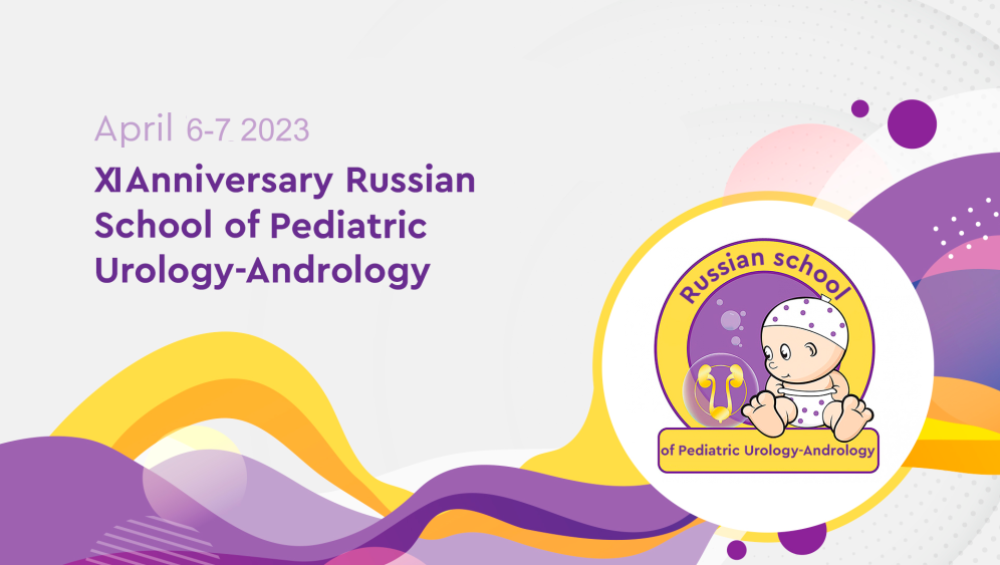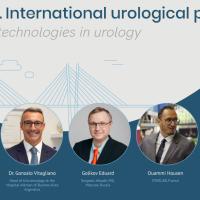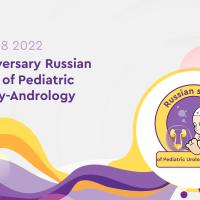
Abstracts of the XI All-Russian School of Pediatric Urology - Andrology
THE USE OF A FLEXIBLE URETERORENOSCOPE FOR THE TREATMENT OF UROLITHIASIS IN CHILDREN
Morozov Children's City Clinical Hospital, Moscow, Russia




.png)

.png)
.png)
.png)
Introduction
Several recent studies show that the use of modern flexible ureterorenoscopes has significantly expanded the possibilities of contact lithotripsy. It is a good alternative to shockwave lithotripsy (ESWL) or percutaneous nephrolithotripsy (PSNL), surpassing them in efficiency and invasiveness, respectively.
The purpose
To improve the results of children with urolithiasis treatment.
Materials and methods
In the period 11.2021–02.2023, 20 children with stones from 7 to 25 mm were treated in the urology departments of the Morozov Children's Clinical Hospital, using a flexible ureterorenoscope. The mean age of children was 10.5 years, median age was 11.2 years. Before flexible lithotripsy, as the first choice of surgical method, sessions of EWSL were performed in the pelvis of 7 children (3 of them twice), in the calyx in 1, in the upper 1/3 of the ureter in 1 child without success. Also, 1 patient initially tried by PCNL, after was found residual calculus in the calyx.
In 4 children, severe skeletal deformity was observed, associated with spinal muscular atrophy in 2 cases and cerebral palsy in 2 children, where ultrasound and X-ray guidance was difficult to perform ESWL or PCNL.
In 18 children, in preparation for optimal ureterorenoscopy, an internal ureteral JJ stent is placed for a period of 1 to 3 weeks. Calicolithotripsy was performed in 8 (40%) children, pyelolithotripsy in 6 (30%) children, pyelocalicolithotripsy in 1 child, 1 accidental ureterolithotripsy and ureterolithoextraction each. One child underwent only diagnostic flexible pyeloscopy, in this case the calculus was in an isolated calyx, which could not be entered. In 1 (5%) child with spinal muscular atrophy, second-look with a residual stone was performed after the first procedure.
Lithotripsy in all cases was performed with a holmium laser in the dusting or fragmenting mode with a power of 0.6-1 J.
In 2 patients, a flexible endoscope was used as an additional tool inserted into the laparoscopic trocar and calyx to search for a calculus, perform lithoextraction during laparoscopic pyeloplasty.
Thus, in the presented series of 20 patients, the free stone index was 95% (19 children).
Conclusions
The method of contact lithotripsy with a flexible endoscope has shown high efficiency and safety, including a large calculus, and can be successfully performed from preschool age.
Keywords: urolithiasis in children, laser lithotripsy, flexible ureterorenoscopy.
ONE-STAGE TRANSCROTAL ORCHIDOPEXY IN BILATERAL INGUINAL CRYPTORCHIDISM IN CHILDREN
 N.R. Akramov
N.R. Akramov
- Kazan State Medical Academy – Branch of The Russian Medical Academy of Continuous Professional Education, Kazan, Russia
- Republican Clinical Hospital, Kazan, Russia
- Children’s Republican Clinical Hospital, Kazan, Russia

- Kazan State Medical Academy – Branch of The Russian Medical Academy of Continuous Professional Education, Kazan, Russia
- Children’s Republican Clinical Hospital, Kazan, Russia

- Children’s Republican Clinical Hospital, Kazan, Russia

- Tashkent Pediatric Medical Institute, Tashkent, Uzbekistan

- Tashkent Pediatric Medical Institute, Tashkent, Uzbekistan
- Yunusabad Medical Center, Tashkent, Uzbekistan
Introduction
Frequency of cryptorchidism varies and depends on gestational age, affecting 1.0–4.6% of full-term and 1.1–45% of preterm newborns. Treatment of this defect is currently surgical. Orchiopexy is one of the frequent surgical aids in the pediatric surgeon and pediatric urologist practice. The need for bilateral inguinal cryptorchidism to perform several incisions or separate operations on each side by time forces pediatric surgeons to continue searching for the optimal way to correct bilateral cryptorchidism.
The purpose
To determine the possibilities of both testicles fixation with bilateral cryptorchidism in a physiological position in the scrotum through a single surgical approach with fewer complications and improved cosmetic result. Comparing with the previously proposed methods.
Materials and methods
From 2012 to 2021 we treated 92 male children with bilateral inguinal cryptorchidism. All boys underwent the developed method of single-stage transcrotal bilateral orchiopexy, accompanied, if necessary, by laparo-scopic assistance using the method of single-acar laparoscopic access.
Results
The results of treatment of 92 children with bilateral inguinal cryptorchidism (184 gonads) in several clinics using this method are presented. Thanks to the improvement of the technology of orchiopexy in the form of single troacar laparoscopic assistance in cases that do not allow the testicle to be freely lowered into the scrotum, the number of complications associated with surgical access, such as pronounced postoperative edema and inflammation of the postoperative wound area, decreased to 1.62% of cases, and there were no relapses of the disease and persistent inguinal hernias.
Conclusions
We have presented a new method of single-stage transcrotal orchiopexy with laparoscopic assistance and statistically substantiates its use in bilateral inguinal cryptorchidism, which allows fixing both testicles in a physiological position in the scrotum at any position of the testicles in the inguinal region with fewer complications and improved cosmetic result in comparison with the previously proposed methods.
Keywords: cryptorchidism; orchiopexy; complications; children; laparoscopy.
THE FIRST EXPERIENCE OF USING PLATELET RICH PLASMA FOR THE CORRECTION OF PROXIMAL HYPOSPADIAS USING A FREE GRAFT

- Kazan State Medical Academy – Branch of The Russian Medical Academy of Continuous Professional Education, Kazan, Russia
- Republican Clinical Hospital, Kazan, Russia
- Children’s Republican Clinical Hospital, Kazan, Russia

- Kazan State Medical Academy – Branch of The Russian Medical Academy of Continuous Professional Education, Kazan, Russia
- Children’s Republican Clinical Hospital, Kazan, Russia

- Children’s Republican Clinical Hospital, Kazan, Russia
Introduction
The problem of reducing postoperative complications in patients with proximal forms of hypospadias is still actual. Each subsequent correction increases the risk of complications compared to the primary treatment, especially with three or more operations reaching 50%. There are theories about the reduction of penile tissue vascularization after each subsequent correction, which suggest that ways are needed to increase the likelihood of tissue engraftment, especially when using free skin and mucous grafts.
The purpose
To introduce the technology of using autologous platelet rich plasma (PRP) for the treatment of proximal forms of hypospadias using free grafts.
Materials and methods
In 5 patients with proximal hypospadias (penoscrotal in 3 cases and scrotal in 2 cases), PRP was used during the 1st stage of Bracka surgery. Three patients underwent primary correction, one had repeated surgery due to scarring of the urethral skin graft, and one child underwent the fifth correction of scrotal hypospadias using a free skin flap of the foreskin from an identical twin. In all cases, a free skin flap of the inner foreskin leaf or the mucous membrane of the lower lip and/or cheek was used as a graft.
PRP was prepared directly during the operation by taking venous blood from a previously unaffected vein. Immediately after receiving the PRP (2 ml), it was injected under the skin or mucous graft after its fixation to the cavernous bodies. We have not noted intraoperative complications when using PRP, including in the early postoperative period. After the first stage of correction, standard local therapy was prescribed. There was a good graft engraftment with pronounced tissue vascularization without noticeable scarring. There was no shortage of urethral plate tissues.
In three patients, the second stage of correction was performed 6-12 months after the first one. Now, there are no postoperative complications. Patients do not complain, there are no violations of urination. The longest follow-up period after the final correction was 1 year.
Conclusions
Preliminary results of the use of PRP demonstrate good survival of free grafts in the correction of proximal forms of hypospadias. The use of PRP can be considered as a promising technique when performing the first stage of the Bracka operation.
Keywords: proximal hypospadias, autologous platelet rich plasma, Bracka urethroplasty.
THE ROLE OF LOWER URINARY TRACT DISORDERS IN THE RECURRENT URINARY TRACT INFECTION IN CHILDREN

- Altai Regional Clinical Centre for Maternal and Child Health Care, Barnaul, Russia

- Altai State Medical University, Barnaul, Russia

- Altai Regional Clinical Centre for Maternal and Child Health Care, Barnaul, Russia

- Altai Regional Clinical Centre for Maternal and Child Health Care, Barnaul, Russia
Introduction
Recurrent urinary tract infection (UTI) is a common childhood pathology. It may manifest as chronic cystitis, chronic pyelonephritis, asymptomatic bacteriuria. The causes of chronic infection are anatomical defects and functional disorders. The pathology may be frequently combined with vesicoureteral reflux (VUR). The retrograde urine flow from the bladder to the ureter resulted from voiding dysfunction leads to irreversible changes in the kidney parenchyma, including fibrosis, pelvicalyceal system dilation and local or diffuse sclerosis, which require the correction of urodynamic parameters.
Urodynamic study conducted to assess the lower urinary tract function and urodynamic parameters enabled to identify functional disorders of the lower urinary tract and voiding in children with recurrent UTI.
The purpose
To study the correlation between lower urinary tract functional disorders and recurrent infection in children.
Materials and methods
In the period 2019-2022, 364 patients with recurrent UTI – chronic cystitis (N30.2) – 129 children, VUR (Q62.7) – 185 children, chronic pyelonephritis (N11.0-N11. 9) – 50 children were treated in the urological department of the Altai Regional Clinical Centre for Maternal and Child Health Care. The patients underwent examinations and clinical, laboratory, instrumental evaluations according to the clinical guidelines and urodynamic studies including uroflowmetry, uroflow with electromyography (UFEMG) of the pelvic floor muscle, and the pressure-flow analysis.
51,6% (188 children) of patients with recurrent UTI suffered from lower urinary tract disorders; the type of the disorders determined the further tactics of patient management.
Conclusions
1. Using uroflowmetry, UFEMG, pressure-flow analysis in the diagnosing of patients with recurrent UTI allowed to reveal urodynamic disorders in 51,6% of patients.
2. Functional lower urinary tract and voiding disorders are a predisposing factor for UTI development in children.
3. The evaluation of lower urinary tract function and urodynamic parameters is fundamental to diagnose patients with recurrent UTI.
Keywords: urinary tract infection (UTI), cystitis, pyelonephritis, vesicoureteral reflux (VUR), urodynamics, lower urinary tract, uroflowmetry, UFEMG, pressure-flow analysis.
A RARE CASE OF CROSS-FUSED RENAL ECTOPIA

- Children’s city hospital № 9 n. a. G.N. Speransky, Moscow, Russia

- First Moscow State Medical University n. a. I.M. Sechenov (Sechenov University), Moscow, Russia
Introduction
Сross renal ectopia (CRE) is a rare type of congenital anomaly characterized by the displacement of the kidney in the process of embryogenesis to the opposite side, as a result of which both of them are located on the same side, where their fusion poles occur in 85% of cases. We have not found descriptions of observations when an orthotopic cystic dysplastic kidney with a lack of function associated with the pathology of the ureterovesical segment (ureterocele) has a fusion with the lower pole of a cross-dystopian normally formed kidney in the domestic and foreign literature.
The purpose
To demonstrate a unique completed clinical case of diagnosis and treatment of a patient with a CRE of right kidney in combination with cystic dysplasia and lack of orthotopic left kidney function associated with urethrocele.
Materials and methods
The patient, 8 days of life. According to the ultrasound data and a preliminary diagnosis, there were: agenesis of the right kidney, doubling of the left kidney, cystic dysplasia, ureterohydronephrosis of the lower half of the doubled left kidney, ureterocele on the left. To restore the outflow of urine and the function of the lower half of the presumably doubled left kidney, a cystourethroscopy was performed. In a typical place on the right there is a properly formed ureteral mouth, on the left there is a ureterocele, which occupies half the volume of the bladder. With the help of a holmium laser, an articial mouth was formed in the ureterocele to restore the passage of urine.
At the age of 9 months, computed tomography of the organs of the urinary system was performed, cross-dystopia of the right kidney with fusion of the lower pole with a cystic dysplastic orthotopic left kidney was diagnosed.
Laparoscopic nephrureterectomy of a non-functioning orthotopic kidney with cystically altered parenchyma was performed.
After discharge from the hospital, the control examination data indicate complete clinical remission and social adaptation of the patient.
Conclusions
The description of this clinical case can contribute to the correct, timely diagnosis of such a rare pathology, the choice of the optimal method of surgical correction based on the prevailing clinical and laboratory manifestations and the functional status of the urinary system, and the prevention of possible complications.
Keywords: children, kidney cross-dystopia, cystic kidney dysplasia, ureterocele, nephroureterectomy, clinical case.
MICROSURGICAL SUBGROIN VARICOCELECTOMY IN ADOLESCENTS WITH VARICOCELE

- Clinical and Research Institute of Emergency Pediatric Surgery and Trauma, Moscow, Russia

- Clinical and Research Institute of Emergency Pediatric Surgery and Trauma, Moscow, Russia

- National Medical Research Centre of Children's Health, Moscow, Russia
Introduction
Varicocele is a common problem in reproductive medicine. It is detected in 15% of healthy males and in about 35% males with primary infertility. Children and adolescents suffer from it in 12%-25%. According to the current data, advantages of surgical correction of varicocele in children and adolescents increase in testicular volume and sperm concentration (Silay MS, Hoen L, Quadackaers J. 2019), comparing with conservative care and observation. Microsurgical varicocelectomy by the subinguinal access in adults with varicocele is a generally accepted technique for varicocele treatment. In the present article the researchers share their experience in introducing this technique for treating adolescents with varicocele.
The purpose
To improve outcomes after left-sided varicocele in children and adolescents by introducing and optimizing microsurgical subgroin varicocelectomy.
Material and methods
In the period 2015-2022 512 surgeries on microsurgical varicocelectomy by the subgroin access were performed in patients aged 10-17 with left-sided varicocele at the Clinical and Research Institute of Emergency Pediatric Surgery and Trauma (CRIEPST). Mostly there were patients at the age of 15-17 years old (n-384 or 75%). After surgery 5-year catamnestic follow-up with ultrasound examination and dopplerography was done in 398 (77.7%) patients who were examined at different postoperative periods. Varicocele recurrence was registered in 16 cases (3.1%) out of them. At the stage of technique implementation, postoperative complications developed in 12 (2.3%) patients - testicular atrophy in one case (0.2%), testicular hypotrophy in one case (0.2%), 8 cases of hydrocele (1.6%), 2 patients (0.4%) with postoperative hematomas.
Conclusions
On summarizing outcomes after implementation of the technique of microsurgical varicocelectomy in children and adolescents in the CRIEPST, the researchers consider that the discussed technique is a method of choice for surgical treatment of varicocele in adolescents. By improving the technique over the past 5 years, the researchers managed to reduce the rate of complications, such as testicular atrophy and hypotorophy up to 0% and the recurrence rate up to 1%. Microsurgical varicocelectomy by the subgroin access is minimally invasive and easy to perform. Moreover, this type of surgery is also cost-effective in comparison with laparoscopic and endovascular modalities for the varicocele treatment.
Keywords: varicocele, adolescents, varicocelectomy, subgroin access.






